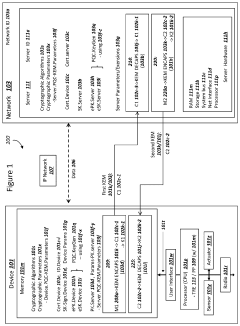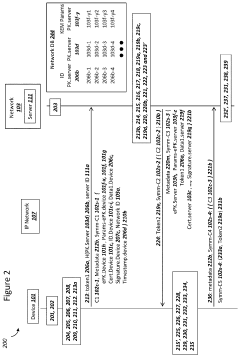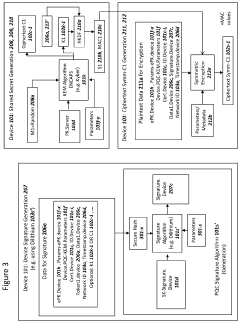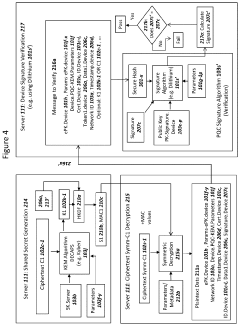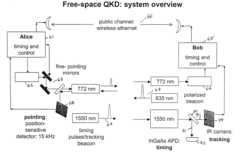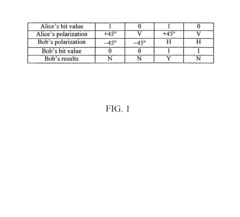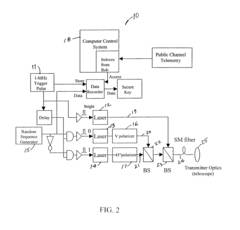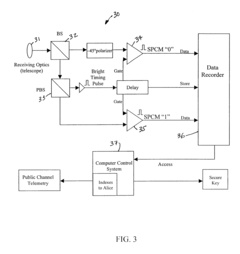Quantum Cryptography: Secure Communication in the Future Internet
JUL 17, 20259 MIN READ
Generate Your Research Report Instantly with AI Agent
Patsnap Eureka helps you evaluate technical feasibility & market potential.
Quantum Cryptography Evolution and Objectives
Quantum cryptography has emerged as a groundbreaking field at the intersection of quantum physics and information security. Its evolution can be traced back to the early 1970s when Stephen Wiesner first proposed the concept of quantum money. However, it was not until the 1980s that the field gained significant momentum with the introduction of quantum key distribution (QKD) protocols.
The development of quantum cryptography has been driven by the growing need for secure communication in an increasingly interconnected world. Traditional cryptographic methods, while effective against current computational capabilities, face potential vulnerabilities in the face of advancing quantum computing technologies. This has led to a surge in research and development efforts aimed at harnessing quantum mechanical principles to create unbreakable encryption systems.
Over the past few decades, quantum cryptography has progressed from theoretical concepts to practical implementations. Key milestones include the first experimental demonstration of QKD in 1989, the development of entanglement-based protocols in the 1990s, and the commercialization of QKD systems in the early 2000s. Recent advancements have focused on extending the range and efficiency of quantum communication channels, as well as addressing practical challenges in real-world deployments.
The primary objective of quantum cryptography is to provide unconditional security in data transmission, leveraging the fundamental principles of quantum mechanics. This includes the development of quantum-resistant cryptographic algorithms and the creation of quantum networks capable of distributing encryption keys over long distances. Additionally, researchers aim to integrate quantum cryptographic solutions with existing communication infrastructure to ensure a smooth transition to quantum-secure systems.
Looking ahead, the field of quantum cryptography is poised to play a crucial role in shaping the future of secure communication. As the Internet continues to evolve and expand, the need for robust encryption methods becomes increasingly critical. Quantum cryptography offers the promise of information-theoretic security, immune to advances in computational power or algorithmic breakthroughs. This makes it an essential component in safeguarding sensitive data across various sectors, including finance, healthcare, and national security.
The ongoing research in quantum cryptography is not only focused on enhancing security but also on improving the practicality and scalability of quantum communication systems. This includes efforts to develop more efficient quantum light sources, detectors, and repeaters, as well as exploring novel protocols that can operate in noisy and lossy environments. The ultimate goal is to create a global quantum-secure internet infrastructure that can withstand both classical and quantum attacks, ensuring the confidentiality and integrity of digital communications in the post-quantum era.
The development of quantum cryptography has been driven by the growing need for secure communication in an increasingly interconnected world. Traditional cryptographic methods, while effective against current computational capabilities, face potential vulnerabilities in the face of advancing quantum computing technologies. This has led to a surge in research and development efforts aimed at harnessing quantum mechanical principles to create unbreakable encryption systems.
Over the past few decades, quantum cryptography has progressed from theoretical concepts to practical implementations. Key milestones include the first experimental demonstration of QKD in 1989, the development of entanglement-based protocols in the 1990s, and the commercialization of QKD systems in the early 2000s. Recent advancements have focused on extending the range and efficiency of quantum communication channels, as well as addressing practical challenges in real-world deployments.
The primary objective of quantum cryptography is to provide unconditional security in data transmission, leveraging the fundamental principles of quantum mechanics. This includes the development of quantum-resistant cryptographic algorithms and the creation of quantum networks capable of distributing encryption keys over long distances. Additionally, researchers aim to integrate quantum cryptographic solutions with existing communication infrastructure to ensure a smooth transition to quantum-secure systems.
Looking ahead, the field of quantum cryptography is poised to play a crucial role in shaping the future of secure communication. As the Internet continues to evolve and expand, the need for robust encryption methods becomes increasingly critical. Quantum cryptography offers the promise of information-theoretic security, immune to advances in computational power or algorithmic breakthroughs. This makes it an essential component in safeguarding sensitive data across various sectors, including finance, healthcare, and national security.
The ongoing research in quantum cryptography is not only focused on enhancing security but also on improving the practicality and scalability of quantum communication systems. This includes efforts to develop more efficient quantum light sources, detectors, and repeaters, as well as exploring novel protocols that can operate in noisy and lossy environments. The ultimate goal is to create a global quantum-secure internet infrastructure that can withstand both classical and quantum attacks, ensuring the confidentiality and integrity of digital communications in the post-quantum era.
Market Demand for Quantum-Secure Communications
The market demand for quantum-secure communications is rapidly growing as the threat landscape for cybersecurity evolves. With the advent of quantum computing, traditional encryption methods are becoming increasingly vulnerable, creating a pressing need for quantum-resistant cryptographic solutions. This demand is driven by various sectors, including government agencies, financial institutions, healthcare providers, and large corporations handling sensitive data.
In the government sector, there is a significant push for quantum-secure communications to protect classified information and national security interests. Many countries are investing heavily in quantum technologies, recognizing their potential to revolutionize secure communications. The United States, China, and several European nations have launched initiatives to develop quantum networks and cryptographic systems.
Financial institutions are another major driver of market demand. Banks, investment firms, and insurance companies handle vast amounts of sensitive financial data and are prime targets for cybercriminals. As quantum computers threaten to break current encryption standards, these organizations are actively seeking quantum-resistant solutions to safeguard their operations and maintain customer trust.
The healthcare industry, with its strict data privacy regulations and sensitive patient information, is also a key market for quantum-secure communications. As healthcare systems become increasingly digitized and interconnected, the need for unbreakable encryption becomes paramount to protect patient confidentiality and comply with regulations like HIPAA in the United States and GDPR in Europe.
Telecommunications companies and internet service providers are investing in quantum-secure infrastructure to future-proof their networks. As the backbone of global communications, these companies are under pressure to ensure the long-term security of data transmission across their networks.
The defense and aerospace industries are also significant contributors to the market demand. Military communications, satellite systems, and critical infrastructure require the highest levels of security, making quantum cryptography an attractive solution for these sectors.
Market analysts project substantial growth in the quantum cryptography market over the coming years. While specific figures vary, there is a consensus that the market will experience double-digit growth rates annually. This growth is fueled by increasing awareness of quantum computing threats, advancements in quantum technology, and the gradual maturation of quantum-secure products and services.
As quantum computers become more powerful and accessible, the urgency for implementing quantum-secure communications intensifies. Organizations are recognizing that the transition to quantum-resistant cryptography is not just a future consideration but a present necessity to ensure long-term data security. This realization is driving research, development, and early adoption of quantum cryptographic solutions across various industries, further stimulating market demand.
In the government sector, there is a significant push for quantum-secure communications to protect classified information and national security interests. Many countries are investing heavily in quantum technologies, recognizing their potential to revolutionize secure communications. The United States, China, and several European nations have launched initiatives to develop quantum networks and cryptographic systems.
Financial institutions are another major driver of market demand. Banks, investment firms, and insurance companies handle vast amounts of sensitive financial data and are prime targets for cybercriminals. As quantum computers threaten to break current encryption standards, these organizations are actively seeking quantum-resistant solutions to safeguard their operations and maintain customer trust.
The healthcare industry, with its strict data privacy regulations and sensitive patient information, is also a key market for quantum-secure communications. As healthcare systems become increasingly digitized and interconnected, the need for unbreakable encryption becomes paramount to protect patient confidentiality and comply with regulations like HIPAA in the United States and GDPR in Europe.
Telecommunications companies and internet service providers are investing in quantum-secure infrastructure to future-proof their networks. As the backbone of global communications, these companies are under pressure to ensure the long-term security of data transmission across their networks.
The defense and aerospace industries are also significant contributors to the market demand. Military communications, satellite systems, and critical infrastructure require the highest levels of security, making quantum cryptography an attractive solution for these sectors.
Market analysts project substantial growth in the quantum cryptography market over the coming years. While specific figures vary, there is a consensus that the market will experience double-digit growth rates annually. This growth is fueled by increasing awareness of quantum computing threats, advancements in quantum technology, and the gradual maturation of quantum-secure products and services.
As quantum computers become more powerful and accessible, the urgency for implementing quantum-secure communications intensifies. Organizations are recognizing that the transition to quantum-resistant cryptography is not just a future consideration but a present necessity to ensure long-term data security. This realization is driving research, development, and early adoption of quantum cryptographic solutions across various industries, further stimulating market demand.
Current Quantum Cryptography Challenges
Quantum cryptography faces several significant challenges as it progresses towards widespread implementation in secure communication systems. One of the primary obstacles is the limited transmission distance of quantum key distribution (QKD) systems. Current technologies struggle to maintain quantum states over long distances due to decoherence and signal loss in optical fibers. This limitation restricts the practical application of quantum cryptography to relatively short-range communications, typically under 100 kilometers without quantum repeaters.
Another major challenge is the development of efficient and reliable quantum repeaters. These devices are crucial for extending the range of quantum communication networks, but current implementations are still in their early stages. Quantum repeaters need to overcome issues such as low fidelity in quantum state transfer and the need for long-term quantum memory, which are essential for creating large-scale quantum networks.
The integration of quantum cryptography with existing classical communication infrastructure presents another significant hurdle. Ensuring compatibility and seamless operation between quantum and classical systems requires substantial engineering efforts and may necessitate the development of new protocols and hardware interfaces.
Scalability remains a critical issue for quantum cryptography systems. As the number of users and the complexity of networks increase, managing the distribution and synchronization of quantum keys becomes increasingly challenging. This scalability problem is particularly acute in potential future quantum internet scenarios, where millions of devices might need to establish secure quantum connections simultaneously.
The vulnerability of quantum cryptography systems to side-channel attacks is an ongoing concern. While the quantum key distribution process itself is theoretically secure, practical implementations can be susceptible to attacks that exploit hardware imperfections or operational weaknesses. Addressing these vulnerabilities requires continuous refinement of both hardware and software components of quantum cryptography systems.
Cost-effectiveness is another significant challenge. Current quantum cryptography systems are expensive to implement and maintain, limiting their adoption to high-security applications. Reducing the cost of quantum components, such as single-photon detectors and quantum random number generators, is crucial for broader commercial adoption.
Lastly, the standardization of quantum cryptography protocols and technologies is an ongoing challenge. The lack of widely accepted standards hampers interoperability between different quantum cryptography systems and slows down the development of a robust quantum communication ecosystem. Efforts by international bodies to establish standards are underway but face the complexity of rapidly evolving quantum technologies.
Another major challenge is the development of efficient and reliable quantum repeaters. These devices are crucial for extending the range of quantum communication networks, but current implementations are still in their early stages. Quantum repeaters need to overcome issues such as low fidelity in quantum state transfer and the need for long-term quantum memory, which are essential for creating large-scale quantum networks.
The integration of quantum cryptography with existing classical communication infrastructure presents another significant hurdle. Ensuring compatibility and seamless operation between quantum and classical systems requires substantial engineering efforts and may necessitate the development of new protocols and hardware interfaces.
Scalability remains a critical issue for quantum cryptography systems. As the number of users and the complexity of networks increase, managing the distribution and synchronization of quantum keys becomes increasingly challenging. This scalability problem is particularly acute in potential future quantum internet scenarios, where millions of devices might need to establish secure quantum connections simultaneously.
The vulnerability of quantum cryptography systems to side-channel attacks is an ongoing concern. While the quantum key distribution process itself is theoretically secure, practical implementations can be susceptible to attacks that exploit hardware imperfections or operational weaknesses. Addressing these vulnerabilities requires continuous refinement of both hardware and software components of quantum cryptography systems.
Cost-effectiveness is another significant challenge. Current quantum cryptography systems are expensive to implement and maintain, limiting their adoption to high-security applications. Reducing the cost of quantum components, such as single-photon detectors and quantum random number generators, is crucial for broader commercial adoption.
Lastly, the standardization of quantum cryptography protocols and technologies is an ongoing challenge. The lack of widely accepted standards hampers interoperability between different quantum cryptography systems and slows down the development of a robust quantum communication ecosystem. Efforts by international bodies to establish standards are underway but face the complexity of rapidly evolving quantum technologies.
Existing Quantum Key Distribution Protocols
01 Quantum Key Distribution (QKD) Systems
QKD systems use quantum mechanics principles to generate and distribute secure cryptographic keys. These systems leverage the properties of quantum states to detect any eavesdropping attempts, ensuring the security of key exchange. QKD technology provides a theoretically unbreakable method for secure communication in quantum cryptography.- Quantum Key Distribution (QKD) Systems: QKD systems use quantum mechanics principles to generate and distribute secure cryptographic keys. These systems leverage the properties of quantum states to detect any eavesdropping attempts, ensuring the security of communication channels. QKD technology provides a theoretically unbreakable encryption method, making it highly resistant to attacks from both classical and quantum computers.
- Post-Quantum Cryptography Algorithms: Post-quantum cryptography algorithms are designed to be secure against attacks from both classical and quantum computers. These algorithms use mathematical problems that are believed to be difficult for quantum computers to solve, such as lattice-based cryptography, multivariate cryptography, and hash-based signatures. Implementing these algorithms enhances the security of cryptographic systems in the face of potential quantum computing threats.
- Quantum Random Number Generators: Quantum random number generators exploit the inherent randomness of quantum processes to produce truly random numbers. These devices are crucial for generating unpredictable cryptographic keys and initialization vectors, enhancing the security of encryption systems. By utilizing quantum phenomena, these generators provide a level of randomness that is impossible to achieve with classical methods.
- Quantum-Resistant Blockchain Technology: Quantum-resistant blockchain technology incorporates post-quantum cryptographic algorithms to secure blockchain networks against potential quantum computer attacks. This approach involves updating the digital signature schemes and hash functions used in blockchain systems to ensure long-term security. By implementing quantum-resistant features, blockchain networks can maintain their integrity and confidentiality in the post-quantum era.
- Quantum Entanglement-based Security Protocols: Security protocols based on quantum entanglement leverage the unique properties of entangled particles to create secure communication channels. These protocols utilize the principle that measuring one entangled particle instantly affects its partner, regardless of distance. This property allows for the creation of secure keys and the detection of any interference in the communication channel, providing a high level of security in quantum networks.
02 Post-Quantum Cryptography Algorithms
Development of cryptographic algorithms resistant to attacks by quantum computers. These algorithms are designed to withstand potential threats from future quantum computing capabilities. They include lattice-based, hash-based, and multivariate cryptographic systems that aim to maintain security in a post-quantum world.Expand Specific Solutions03 Quantum Random Number Generators
Quantum random number generators exploit quantum phenomena to produce truly random numbers, which are crucial for cryptographic key generation. These devices enhance the unpredictability and security of encryption keys used in quantum cryptography systems, improving overall security.Expand Specific Solutions04 Quantum-Safe Network Protocols
Development of network protocols and architectures that are resistant to quantum attacks. These protocols aim to secure communication infrastructure against potential quantum computer threats. They include quantum-resistant routing algorithms and quantum-safe blockchain technologies.Expand Specific Solutions05 Quantum Entanglement for Secure Communication
Utilization of quantum entanglement phenomena for secure communication channels. This approach leverages the unique properties of entangled particles to create inherently secure communication links. It includes techniques for long-distance quantum communication and quantum repeaters to extend the range of secure quantum networks.Expand Specific Solutions
Key Players in Quantum Cryptography
The quantum cryptography market is in its early growth stage, with increasing interest from governments and enterprises due to its potential for ultra-secure communication. The global market size is projected to reach several billion dollars by 2030. While the technology is still maturing, significant progress has been made in recent years. Key players like Arqit, Shenzhou Quantum, and Hitachi are advancing commercial applications, while research institutions such as Beijing University of Posts & Telecommunications and University of Aveiro are driving fundamental breakthroughs. Major tech companies including Huawei, Toshiba, and Nokia are also investing heavily in quantum cryptography R&D. The competitive landscape is characterized by a mix of specialized quantum startups, established tech giants, and academic/government research centers.
Arqit Ltd.
Technical Solution: Arqit has developed a unique satellite-based quantum encryption system called QuantumCloud™. This technology uses quantum key distribution to create encryption keys in data centers on the ground, which are then securely distributed via satellite. Arqit's approach eliminates the need for terrestrial quantum links, enabling global coverage and overcoming distance limitations of fiber-based QKD systems [10]. The company's technology incorporates a novel symmetric key agreement protocol that enhances security and reduces computational overhead. Arqit has also developed quantum random number generators to ensure the unpredictability of generated keys. Their system is designed to be quantum-safe, protecting against both current and future quantum computer attacks [11].
Strengths: Global coverage through satellite distribution, scalable solution for large networks, and quantum-safe design. Weaknesses: Potential vulnerabilities in satellite-to-ground links and reliance on complex space infrastructure.
British Telecommunications Plc
Technical Solution: BT has developed a quantum-secured network infrastructure using QKD technology. Their system employs a combination of quantum and classical channels to distribute encryption keys and transmit data securely. BT's approach focuses on integrating QKD with existing fiber optic networks, allowing for seamless deployment in urban environments [4]. They have implemented a novel trusted node architecture to extend the range of quantum communication beyond the typical 100 km limit [5]. BT has also developed quantum random number generators to enhance the unpredictability of encryption keys. The company has successfully demonstrated a quantum-secured video conference between two geographically separated locations, showcasing the practical application of their technology [6].
Strengths: Integration with existing fiber infrastructure, extended range through trusted node architecture, and practical demonstrations of technology. Weaknesses: Reliance on trusted nodes may introduce potential security vulnerabilities, and the system may be susceptible to side-channel attacks.
Core Quantum Cryptography Innovations
System and Methods for Secure Communication Using Post-Quantum Cryptography
PatentPendingUS20230361994A1
Innovation
- Implementing a system where a device and server use multiple post-quantum cryptography key encapsulation mechanisms (KEM) algorithms, including lattice-based, code-based, and Supersingular Isogeny Key Encapsulation (SIKE), to derive multiple independent shared secrets, ensuring security even if one algorithm is compromised, and using static and ephemeral keys to resist quantum computer attacks and 'Man in the Middle' threats.
Method and apparatus for free-space quantum key distribution in daylight
PatentInactiveUS6748083B2
Innovation
- The apparatus uses multiple lasers to generate polarized optical data states, with a random bit generator selecting which lasers to enable, and a beam splitter to transmit or reflect data pulses, allowing for secure key generation over atmospheric links using the B92 or BB84 protocols, incorporating a timing pulse for synchronization and error correction.
Quantum-Safe Standardization Efforts
Quantum-safe standardization efforts are crucial in preparing for the post-quantum era of cryptography. As quantum computers advance, they pose a significant threat to current cryptographic systems, particularly those based on public-key algorithms. To address this challenge, various international organizations and standardization bodies are actively working on developing quantum-resistant cryptographic standards.
The National Institute of Standards and Technology (NIST) in the United States has been at the forefront of these efforts. In 2016, NIST initiated a process to standardize post-quantum cryptographic algorithms. This process involves multiple rounds of evaluation and selection, with the goal of identifying robust quantum-resistant algorithms for public-key encryption, key establishment, and digital signatures.
The European Telecommunications Standards Institute (ETSI) has also been actively involved in quantum-safe standardization. ETSI's Quantum-Safe Cryptography Working Group focuses on developing standards and guidelines for the transition to quantum-safe cryptography. Their work includes analyzing the impact of quantum computing on current cryptographic systems and proposing quantum-resistant alternatives.
The International Organization for Standardization (ISO) and the International Electrotechnical Commission (IEC) have established a joint working group (ISO/IEC JTC 1/SC 27/WG 2) dedicated to cryptography and security mechanisms. This group is working on developing standards for quantum-resistant cryptographic techniques, including lattice-based, code-based, and multivariate cryptography.
In addition to these efforts, the Internet Engineering Task Force (IETF) has been exploring the integration of quantum-safe algorithms into existing internet protocols. Their work includes developing guidelines for hybrid key exchange mechanisms that combine classical and post-quantum algorithms to ensure both backward compatibility and future security.
The Cloud Security Alliance (CSA) has also contributed to quantum-safe standardization through its Quantum-Safe Security Working Group. This group focuses on educating the industry about quantum computing risks and promoting the adoption of quantum-safe security practices.
These standardization efforts are essential for ensuring a smooth transition to quantum-safe cryptography. They provide a framework for developing, testing, and implementing quantum-resistant algorithms across various industries and applications. As these standards evolve, they will play a crucial role in safeguarding sensitive information and maintaining secure communication in the future internet landscape.
The National Institute of Standards and Technology (NIST) in the United States has been at the forefront of these efforts. In 2016, NIST initiated a process to standardize post-quantum cryptographic algorithms. This process involves multiple rounds of evaluation and selection, with the goal of identifying robust quantum-resistant algorithms for public-key encryption, key establishment, and digital signatures.
The European Telecommunications Standards Institute (ETSI) has also been actively involved in quantum-safe standardization. ETSI's Quantum-Safe Cryptography Working Group focuses on developing standards and guidelines for the transition to quantum-safe cryptography. Their work includes analyzing the impact of quantum computing on current cryptographic systems and proposing quantum-resistant alternatives.
The International Organization for Standardization (ISO) and the International Electrotechnical Commission (IEC) have established a joint working group (ISO/IEC JTC 1/SC 27/WG 2) dedicated to cryptography and security mechanisms. This group is working on developing standards for quantum-resistant cryptographic techniques, including lattice-based, code-based, and multivariate cryptography.
In addition to these efforts, the Internet Engineering Task Force (IETF) has been exploring the integration of quantum-safe algorithms into existing internet protocols. Their work includes developing guidelines for hybrid key exchange mechanisms that combine classical and post-quantum algorithms to ensure both backward compatibility and future security.
The Cloud Security Alliance (CSA) has also contributed to quantum-safe standardization through its Quantum-Safe Security Working Group. This group focuses on educating the industry about quantum computing risks and promoting the adoption of quantum-safe security practices.
These standardization efforts are essential for ensuring a smooth transition to quantum-safe cryptography. They provide a framework for developing, testing, and implementing quantum-resistant algorithms across various industries and applications. As these standards evolve, they will play a crucial role in safeguarding sensitive information and maintaining secure communication in the future internet landscape.
Quantum Cryptography Implementation Costs
The implementation costs of quantum cryptography systems remain a significant barrier to widespread adoption, despite the technology's promising security advantages. Current quantum key distribution (QKD) systems require specialized hardware components, including single-photon sources, detectors, and quantum random number generators. These components are often expensive and challenging to manufacture at scale, contributing to the high overall cost of quantum cryptography implementations.
Infrastructure requirements also play a crucial role in the cost structure. Quantum cryptography systems typically rely on dedicated fiber optic networks or free-space optical links for transmitting quantum states. Establishing and maintaining these specialized communication channels can be costly, especially when integrating them into existing network infrastructures. Additionally, the limited transmission distance of quantum signals necessitates the use of quantum repeaters or trusted nodes, further increasing the complexity and cost of large-scale deployments.
The operational expenses associated with quantum cryptography systems are another significant factor. These systems require highly skilled personnel for installation, configuration, and maintenance, adding to the ongoing costs. Moreover, the need for precise calibration and alignment of optical components demands specialized expertise and equipment, contributing to higher operational expenditures compared to classical cryptographic systems.
Scalability challenges also impact the overall implementation costs. As quantum cryptography networks expand, the number of required quantum devices and infrastructure components increases, potentially leading to exponential cost growth. This scalability issue is particularly pronounced when considering the integration of quantum cryptography into large-scale communication networks or global internet infrastructure.
Research and development costs continue to be a substantial component of quantum cryptography implementation expenses. Ongoing efforts to improve the performance, reliability, and cost-effectiveness of quantum cryptography systems require significant investments in both basic and applied research. These R&D costs are often reflected in the pricing of commercial quantum cryptography solutions, contributing to the overall high implementation costs for end-users and organizations.
Despite these challenges, advancements in quantum technologies and manufacturing processes are gradually reducing implementation costs. Innovations in integrated photonics, more efficient single-photon detectors, and improved quantum random number generators are helping to lower hardware expenses. Additionally, the development of hybrid classical-quantum cryptography systems and software-defined quantum cryptography solutions may offer more cost-effective implementation options in the future, potentially accelerating the adoption of quantum-secure communication technologies.
Infrastructure requirements also play a crucial role in the cost structure. Quantum cryptography systems typically rely on dedicated fiber optic networks or free-space optical links for transmitting quantum states. Establishing and maintaining these specialized communication channels can be costly, especially when integrating them into existing network infrastructures. Additionally, the limited transmission distance of quantum signals necessitates the use of quantum repeaters or trusted nodes, further increasing the complexity and cost of large-scale deployments.
The operational expenses associated with quantum cryptography systems are another significant factor. These systems require highly skilled personnel for installation, configuration, and maintenance, adding to the ongoing costs. Moreover, the need for precise calibration and alignment of optical components demands specialized expertise and equipment, contributing to higher operational expenditures compared to classical cryptographic systems.
Scalability challenges also impact the overall implementation costs. As quantum cryptography networks expand, the number of required quantum devices and infrastructure components increases, potentially leading to exponential cost growth. This scalability issue is particularly pronounced when considering the integration of quantum cryptography into large-scale communication networks or global internet infrastructure.
Research and development costs continue to be a substantial component of quantum cryptography implementation expenses. Ongoing efforts to improve the performance, reliability, and cost-effectiveness of quantum cryptography systems require significant investments in both basic and applied research. These R&D costs are often reflected in the pricing of commercial quantum cryptography solutions, contributing to the overall high implementation costs for end-users and organizations.
Despite these challenges, advancements in quantum technologies and manufacturing processes are gradually reducing implementation costs. Innovations in integrated photonics, more efficient single-photon detectors, and improved quantum random number generators are helping to lower hardware expenses. Additionally, the development of hybrid classical-quantum cryptography systems and software-defined quantum cryptography solutions may offer more cost-effective implementation options in the future, potentially accelerating the adoption of quantum-secure communication technologies.
Unlock deeper insights with Patsnap Eureka Quick Research — get a full tech report to explore trends and direct your research. Try now!
Generate Your Research Report Instantly with AI Agent
Supercharge your innovation with Patsnap Eureka AI Agent Platform!
